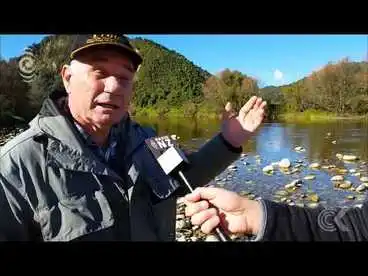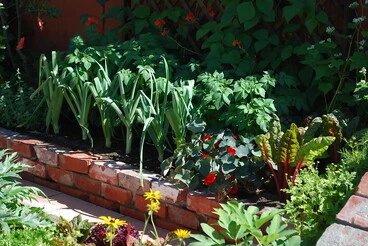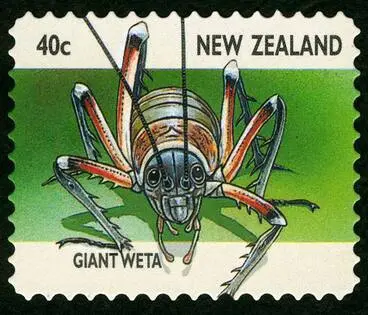New Zealand's Fresh Water
A DigitalNZ Story by National Library of New Zealand Topics
New Zealand has vast freshwater resources (glaciers, rivers, swamps, creeks and lakes). This topic covers water conservation, sustainability, pollution, tax, bottled water, rivers, flooding and the water rights of the Māori. SCIS no: 1894554
Brighter future?: A tale of two rivers captures water quality debate
Radio New Zealand
Ngāi Tahu takes Crown to court for 'rangatiratanga' of its waterways
Services to Schools
Farming and environmental pollution
Science Learning Hub
Water run-off weirs
Manatū Taonga, the Ministry for Culture and Heritage
Water pollution
Manatū Taonga, the Ministry for Culture and Heritage
A Visit from the Water Watch Dogs
Alexander Turnbull Library
Bottled New Zealand water
DigitalNZ
Iwi protest over wastewater plans
Radio New Zealand
Vox Pop: Do you care about clean rivers?
Radio New Zealand
Rivers in flood
Manatū Taonga, the Ministry for Culture and Heritage
Riverbank planting
Manatū Taonga, the Ministry for Culture and Heritage
Hundreds of farmers protest water tax in Labour leader's hometown
Radio New Zealand
River
Manatū Taonga, the Ministry for Culture and Heritage
Cows near Russell
Auckland Libraries
Flooding, Whakatāne
Manatū Taonga, the Ministry for Culture and Heritage
Crown found to be complicit in lake's pollution
Radio New Zealand
Protests nation-wide over water rights
Radio New Zealand
Tests reveal source of Havelock North water contamination
Radio New Zealand
Calculating water quality
Services to Schools
Water New Zealand
Services to Schools
Wasting water
Services to Schools
Health warning
Services to Schools
New Zealand’s freshwater
Services to Schools
New Zealand rivers
Services to Schools
Māori values in protecting new Zealand rivers
Services to Schools
Is it safe to swim?
Services to Schools
Creating silt traps on lakes
Services to Schools
Tuna – loss of habitat
Services to Schools
Recreational water
Services to Schools
Freshwater
Services to Schools
NZ rivers for recreation
Services to Schools
The bottled-water giants
Services to Schools
Freshwater for life
Services to Schools
Jenny Salesa vows political support for water-only schools
Services to Schools
Students are cleaning up Otara Creek
Services to Schools
How safe is your school’s water supply?
Services to Schools
Gutters and drains lead to rivers and streams
Services to Schools
Up the creek
Services to Schools
Dairy farms use the equivalent water of 60 million people
Services to Schools
Half a ton of whitebait
Services to Schools
This cartoon refers to the shipment of NZ Miracle drinking water being sent back from China because the level of nitrate in the water is higher than the accepted Chinese standard of 0.005mg per litre. Miracle chief executive Xinghong Ju said that Hawke’s Bay water was chosen for its purity, taste and low mineral content. The irony expressed in the 2016 cartoon was that in the same year China topped the list of the world's deadliest country for outdoor air pollution according to WHO.
New Zealand water in China
Alexander Turnbull Library
Protests in Westland
Gold mining in early New Zealand depended heavily on water for alluvial gold extraction using hydraulic processes. This article reports on the opposition to water-power regulations by the government and the charges imposed by the Mining Act to the Rimu-Seddon’s Terrace goldfield. The general opinion was that these charges would stifle the enterprise. Instead, it was recommended that power charges should be waived until the venture proved to be a success.
National Library of New Zealand
Flax polluting rivers
River pollution in New Zealand is not a recent event. Over 100 years ago Acclimatisation Societies claimed that a flaxmiller in Taupiri near Ngaruawahia was polluting the Waikato river. The Auckland Flax millers Association in-turn stated that if a prosecution was taken it would mean the end of not only flaxmilling but also the Dairy industry. Acclimatisation societies were set up around New Zealand in the 1860s. They were responsible for importing plants and animals from overseas countries into New Zealand. Their worry was that if the Waikato became too polluted it would not sustain populations of trout and ducks that were fishing and hunted along the river.
National Library of New Zealand
Polluted rivers–exporting water
The tuna in the image are addressing 2 issues currently being hotly debated in New Zealand. The first is the pollution of our rivers which raises questions about our overseas ‘clean green 100%’ image. The second issue is the controversy around the export of bottled New Zealand freshwater to overseas countries by foreign companies.
Alexander Turnbull Library
Green image
Waterways and rivers being polluted by animal excrement and nitrates from farms was much in the news in 2013. The Parliamentary Commissioner for the Environment reported that the country was facing an environmental disaster. However, this farmer seems to disagree. His sample of water in a bottle looks green enough to keep up with New Zealand’s pure, green image. Of course, the green colour of water in his bottle is probably the result of animal excrement or the build-up of algae in the water as a result of nitrates.
Alexander Turnbull Library
Flooding of the Clutha River
The Clutha River is the longest river in the South Island and also has the largest catchment. Petitioners in 1906 requested that the Government take steps to protect properties in South Molyneux, Inch Clutha, Matau and Kaitangata from getting flooded by the Clutha River due to a build-up of silt washed down from gold mines. The Goldfields and Mines Committee, in turn, recommended that the Government send an engineer to report on the silting up of the river bed and that a sum of 300 pounds should be made available to carry out the work required.
National Library of New Zealand
The drought
Drought is a result of deficit rainfall and can significantly hamper farming activities as can be seen in this article from 1907. The amount of Cocksfoot (a type of grass) gathered in Banks Peninsula was very small and the supply of milk was reduced by half. In Ashburton many farmers were thinning down their flock by selling them at a loss or sending them to the freezing works to be boiled down for tallow. In Central Otago it was just as bad. The feed for sheep was completely eaten down while the turnip crop was a failure.
National Library of New Zealand
Freshwater fish of New Zealand
Services to Schools
The human impact on rivers
Services to Schools
Great New Zealand River Journeys
NZ On Screen
Māori and rivers
Manatū Taonga, the Ministry for Culture and Heritage
Freshwater taniwha
Manatū Taonga, the Ministry for Culture and Heritage
NZ running out of wetland areas
Services to Schools
Sustainability
DigitalNZ
Dirty Dairying
Services to Schools
Essential freshwater new rules and regulations
Services to Schools
Kōpūwai and the Clever Girl
Services to Schools
Talking to the River : School Journal Level 3 June 2018
Services to Schools
Bottled water has reached its tipping point
Services to Schools
Impacts of hydro
Services to Schools
Project Twin Streams
Services to Schools
Maori water rights: Iwi leaders open to deal to keep it out of court
Services to Schools
Freshwater quality decline threatens native species
Services to Schools
Māori water rights case aims to stop water bottlers
Services to Schools
Mass poisoning
Services to Schools
Improving fresh water quality in New Zealand
Services to Schools












